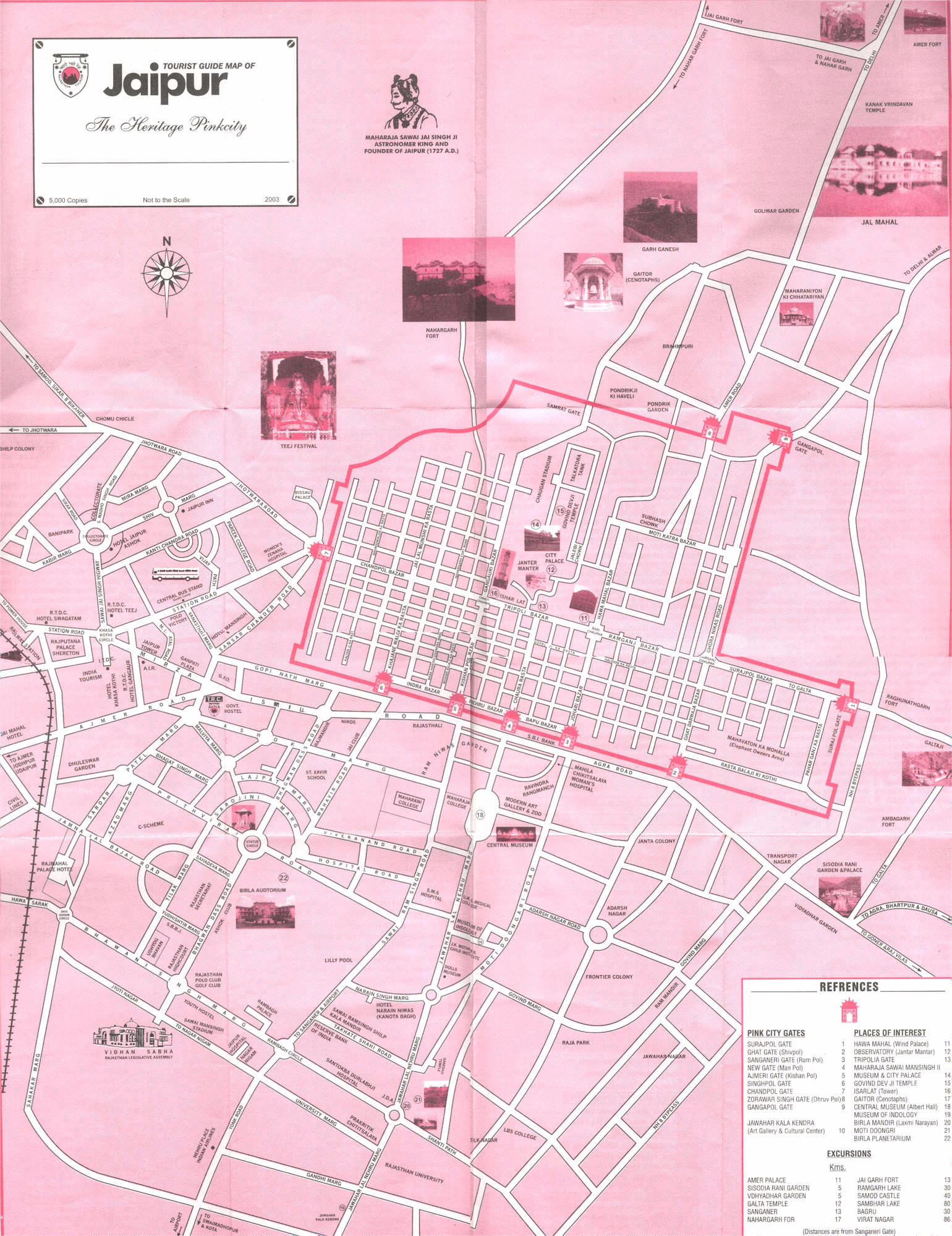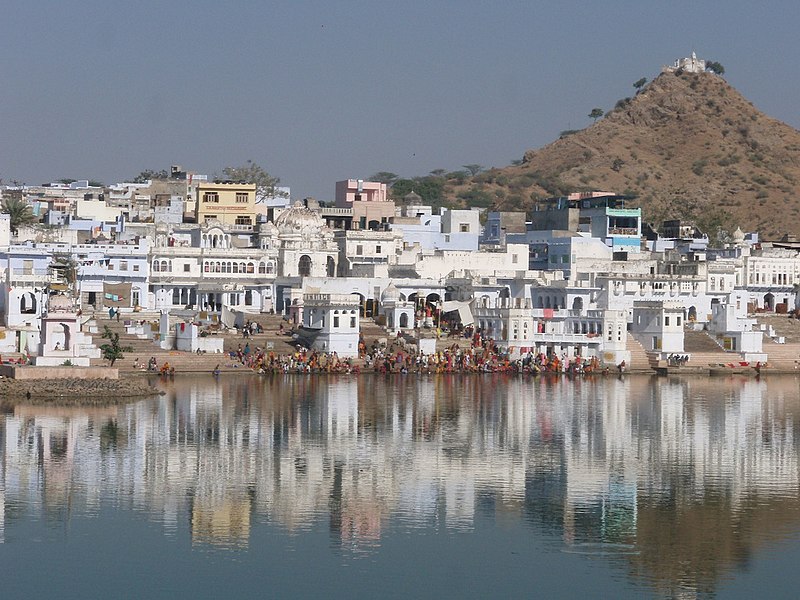Gentlefolk,
This post describes our stay in Jaipur (aka The Pink City), capital of Rajasthan State, 26 & 27 February 2020.
 |
| Map of Rajasthan State. Our tour visited Jaipur (the State capital), Pushkar, Jodhpur, and Udaipur. |
 |
In 1727 Jai Singh transferred his capital from Amber to Jaipur because of population pressures and lack of water in Amber. His architect, Vidhadyar, laid out the city on a grid system, with the Palace in the center. That area is now called the Old City, or the Pink City.
In 1876 the then-Maharaja ordered all buildings to be painted pink to welcome the Prince of Wales (later King Edward V11) - can you believe painting a whole city for the sake of a two day visit???
That tradition continues today - all the residents of the Old City must paint their premises pink (or sometimes a shade of brown). |
 |
| We arrived at the Sarovar Premier Hotel in Jaipur late on Tuesday 25 February, having driven from Agra that afternoon (see Post #205). |
 |
| Don't bring guns into the hotel...! I wonder what this warning referred to - perhaps a previous incident? The only guns we saw during the tour were with policemen or security guards. |
 |
| Wednesday morning 26 February we visited Amber Fort, 11km from Jaipur. A view of Amber Fort from the carpark - impressive - built from yellow and pink sandstone and white marble. This was the ruler's fort/palace from 1592 until 1727 when Jai Singh (1688 - 1744) built his new palace and city at Jaipur. |
 |
| Snake charmers. We only saw these two during our trip - apparently the govt has banned this activity. |
 |
| We took Jeeps from the carpark up to the Fort .... |
 |
| ... but riding an Elephant would have been fun. |
 |
| The Main Courtyard (Jaleb Chowk) of Amber Fort is very large; there are 3 other, smaller, courtyards. |
 |
| Our group in the Main Courtyard. |
 |
| Entrance to the Maharaja's living apartments through the fabulous Ganesh Pol gate. |
 |
| A lovely archway and beautifully tiled walls leading to the Hall of Pleasure. |
 |
| Jeeps lined up waiting to take tourists from the Fort down to the carpark. The swastika is a common Hindu symbol. |
 |
| Diwan offering trinkets from local sellers. |
 |
| We had lunch in the Green Pigeon restaurant. A man played music on a mandolin-like instrument (he is sitting cross-legged on the right of the photo), while his young son entertained the diners with folk dancing. It was good to see some local culture rather than just ancient monuments. |
 |
| A specialist guide showed us around Jantar Mantar, the extensive Observatory built by Jai Singh in 1728 (unfortunately the guide's English was difficult to understand, but we got the gist). Jai Singh was fascinated by astronomy and horoscopes. The instruments were precision-built and still work today. |
 |
| We visited the City Palace, originally built by Jai Singh, and extended by future rulers. |
 |
| The Inner Courtyard of the Palace has four gateways/doors each dedicated to a season. This Indian girl is in front of the Peacock Gate which depicts autumn. |
 |
| Another lovely courtyard in the Palace. |
 |
| A room in the Palace was set aside for local handicrafts. Here we watched an artist do miniature painting. |
 |
| Vera bought some pashmina scarves. |
 |
| From the Palace we visited Tribal Arts Cooperative. |
 |
| A lady making carpet on a traditional loom. This establishment specialises in using camel wool and yak wool. |
 |
| They wash the carpets - the last step in the process. |
 |
| Driving back to the hotel, we passed Hawal Mahal, built in 1799 by Maharaja Prapat Singh to for the ladies of the royal household. They could sit in the windows and watch the life of the city below. |
 |
| The Central Museum looked spectacular all lit up at night. This grand old building, originally called Albert Hall, was designed by Sir Swinton Jacob and combines elements of English and North Indian architecture. |
 |
| The following morning, Thursday 27 February, Diwan came to our hotel - here he is paying for his autorickshaw ride. He took us for a walk around a wholesale fresh fruit & vegetable market which was just behind the Hotel Sarovar Premier, before we set off for our next destination, Pushkar. The following photos were taken in the Wholesale Market. |
 |
| Diwan said that big cities have supermarkets, but most Indians still like to buy their daily requirements at markets such as this one. The don't like refrigerated/frozen veges - much prefer fresh. This place was a hive of activity. |
 |
| Story on the front page of The Times of India described the aftermath of the Hindu - Moslem clashes in northeast Delhi on the previous two days. The death toll had reached 27 - but the final count was much higher at 53, with more than 200 injured and many buildings damaged. |
...
After visiting the wholesale fruit and vegetable market we set off for our next destination, Pushkar. That will be the subject of my next post.
...
The coronavirus
It is exactly a month since we left Sydney on Saturday 22 February 2020 for the start of our Indian holiday. But hasn't the world changed in that short time???
The Australian stock market hit its peak on 21 February 2020 and the coronavirus (CV19) was basically restricted to China, with very little impact on other countries - it was "page 3" news here. But now, just a month later, CV19 is 'front page' news, all day, every day.
Stock markets around the world have crashed - the Aussie stock market is down more than 30%!
Europe has become the epicenter of the pandemic. Today China reported no new infections (hurrah!), while Italy reported 427 deaths in one day for a total of nearly 4,000! No one really knows the situation in the USA - the numbers are still relatively small (18,000 infections, 272 deaths) but rising rapidly.
Here is an abbreviated timeline for CV19:
16 December 2019: first patient with new virus admitted to Wuhan Central Hospital, Hubei Province, China.
31 December: 27 cases in Wuhan; traced to wet market, which is closed down; China informs the WHO of a new mystery virus.
13 January 2020: first case outside China - in Thailand.
20 January: First case in South Korea. China advises the virus can spread between humans.
21 January: CDC in US confirms first case there.
23 January: Wuhan, a city of 15 million, locked down (but many people had already left Wuhan to celebrate Chinese New Year 25/1 with their families).
24 January: Lock-down extended to cities around Wuhan.
12 March: WHO declares a pandemic.
14 March: President Trump declares a national emergency in the USA.
The WHO said that it took 3 months to reach 100,000 CV19 infections, but only another 12 days to reach 200,000. It is accelerating.
When we arrived back in Australia on Monday 16 March there were 183,198 infected cases worldwide, with 7,165 deaths. Today, just 5 days later, the figures are 265,495 infected and 11,147 deaths. In Australia the numbers have jumped from 438 with 5 deaths, to over 800 with 7 deaths.
Dire economic forecasts of recession or worse. Governments have announced stimulus packages - pumping money to underpin their economies. Most countries have closed their borders.
"Social distancing" and "Self-isolation" are new words, suddenly in everyday use.
How quickly things can/have changed. Incredible - if you told me a four weeks ago that the world would be on the edge of a medical and economic precipice no one would have believed it.
Playboy announced today the end of it's printed version, after 66 years. Bunnings announced no sausage sizzles until further notice.
And there is still a long way to go ...
...
Best wishes, stay healthy and keep smiling.
Vera & Alex Olah
Canberra, Australia
Saturday, 21 March 2020

























































































